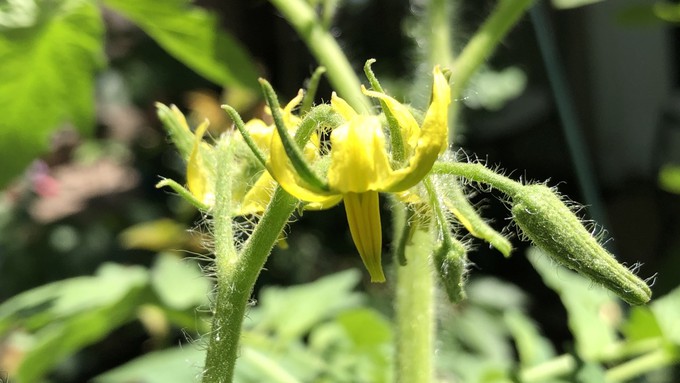
Triple-digit temperatures can affect pollination, tomato development

Extreme heat shuts down production in tomato plants: pollen dries up and the flowers won't set fruit. Kathy Morrison
High heat is on its way – and that’s bound to affect our tomatoes.
First this update from the National Weather Service: Saturday is going to be hot!
A heat advisory is in effect from 11 a.m. to 8 p.m. Saturday, June 22, says the weather service.
“High temperatures 100 to 107 expected. Limited overnight relief with low temperatures in the mid 60s to mid 70s.”
The areas expected to be hardest hit include central Sacramento Valley, Mother Lode, northern Sacramento Valley, northern San Joaquin Valley and southern Sacramento Valley, says the advisory. The warmest overnight temperatures will be in the northern and central Sacramento Valley and foothills.
Saturday’s high temperature in downtown Sacramento is expected to reach 103, says the weather service. That’s 15 degrees above normal.
Be prepared to keep the A.C. running all night. Stay hydrated. Bring pets indoors.
But we can’t bring our vegetable gardens indoors. They have to cope where they’re planted.
So concentrate on keeping them comfortable. Water deeply in the morning before the heat arrives. Make sure there’s mulch (straw, leaves, wood chips, etc.) to help retain that moisture and keep roots cool. Erect some temporary shade (such as an umbrella or shade cloth) over peppers and tender transplants.
Tomatoes and large-leaved vegetables such as squash tend to wilt in the afternoon; that’s a normal coping mechanism. If they’re still wilted in the morning, they need a drink.
Speaking of tomatoes, the top issue right now is lack of pollination. Plants have blooms, but they drop off before they form fruit.
That’s related to heat, too. Tomato flowers won’t set when temperatures stay high – over 90 degrees – for prolonged periods. The pollen dries out. But indeterminate varieties will produce more flowers with new growth.
Tomatoes like some heat; days between 80 and 90 degrees produce optimum growth, according to UC research. But flowers will not set on 100-degree days.
Heat isn’t the only weather factor that can affect tomato pollination. Lack of wind or breeze also can affect tomato set. Tomatoes generally are wind-pollinated. To help with pollination, gently wiggle the tomato’s cage or trellis to shake up and spread the pollen.
For more advice on tomatoes and other summer crops, check out the UC IPM website: https://ipm.ucanr.edu/.
Comments
0 comments have been posted.Sacramento Digs Gardening to your inbox.
Food in My Back Yard Series
May 6: Maintain soil moisture with mulch for garden success
April 29: What's (already) wrong with my tomato plants?
April 22: Should you stock up on fertilizer? (Yes!)
April 15: Grow culinary herbs in containers
April 8: When to plant summer vegetables
April 1: Don't be fooled by these garden myths
March 25: Fertilizer tips: How to 'feed' your vegetables for healthy growth
March 18: Time to give vegetable seedlings some more space
March 11: Ways to win the fight against weeds
March 4: Potatoes from the garden
Feb. 25: Plant a fruit tree now -- for later
Feb. 18: How to squeeze more food into less space
Feb. 11: When to plant? Consider staggering your transplants
Feb. 4: Starting in seed starting
Sites We Like
Garden Checklist for week of May 11
Make the most of the lower temperatures early in the week. We’ll be back in the 80s by Thursday.
* Plant, plant, plant! It’s prime planting season in the Sacramento area. Time to set out those tomato transplants along with peppers and eggplants. Pinch off any flowers on new transplants to make them concentrate on establishing roots instead of setting premature fruit.
* Direct-seed melons, cucumbers, summer squash, corn, radishes, pumpkins and annual herbs such as basil.
* Harvest cabbage, lettuce, peas and green onions.
* In the flower garden, direct-seed sunflowers, cosmos, salvia, zinnias, marigolds, celosia and asters. (You also can transplant seedlings for many of the same flowers.)
* Plant dahlia tubers.
* Transplant petunias, marigolds and perennial flowers such as astilbe, columbine, coneflowers, coreopsis, dahlias, rudbeckia and verbena.
* Keep an eye out for slugs, snails, earwigs and aphids that want to dine on tender new growth.
* Feed summer bloomers with a balanced fertilizer.
* For continued bloom, cut off spent flowers on roses as well as other flowering plants.
* Add mulch to the garden to maintain moisture. Mulch also cuts down on weeds. But don’t let it mound around the stems or trunks of trees or shrubs. Leave about a 6-inch-to-1-foot circle to avoid crown rot or other problems.
* Remember to weed! Pull those nasties before they set seed.
* Water early in the day and keep seedlings evenly moist.